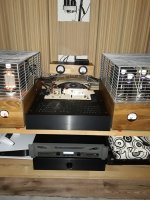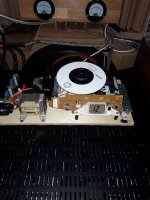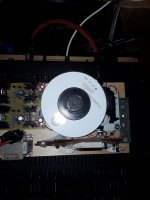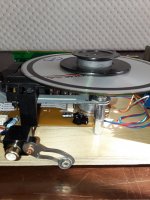I’ve been repairing CD, DVD, and SACD players for a long time. In fact I began repairing CD players in the late 1980’s.Hi everybody!
I want to share some information that can help those who have a Sanyo DA11 transport with a laser head SF-P101 reads discs poorly.
This week I was repairing my Philips AZ1065 boombox, which first began to read discs with errors after just a year of operation and then completely stopped recognizing discs. Cleaning the lens didn't help, and cleaning and lubricating the mechanics didn't help either. I noticed that during the test described in the Philips AZ1065 service manual, the carriage motor cannot move it normally.
I began to check the condition of the motors. In the service manual of the Sanyo DA11 (SF-P101) drive, it is indicated that the motors should start rotating at a voltage of 0.8 volts or less. The disc motor started rotating at 0.6 volts, and the carriage motor only at 1.65 volts. Since the motors are the same, I measured the resistance of the motors with an ohmmeter. The disc motor had a resistance of about 12 оhms. The resistance of the carriage motor varied chaotically within a few hundred оhms.
I disassembled this motor. Its collector plates darkened to blue-black. I cleaned the collector plates with a rubber eraser and alcohol to a silvery color and reassembled the motor. Its resistance became 11.3 ohms in all rotor positions. After that, the drive began to perfectly read all discs - CD, CD-R and CD-RW.
Valery.
Faulty or intermittent spindle motors and sled drive (carriage drive) motors are an extremely common fault.
There are 3 main “families” of these tiny low-voltage DC motors. They were first manufactured by Mabuchi. The Mabuchi part numbers are now used by numerous different Asian vendors who make small DC motors. The most popular “generic” part numbers are:
RF-310
RF-320
RF-300
A quick search of ebay and alibaba reveals 100’s of vendors selling the current versions of these motors for prices from USD $2 to $12 each. I keep a stock on hand of at least 2 or 3 motors of each different part number and shaft length.
The “shaft length” isn’t specified by the part number of the motor. However, the ebay and alibaba vendors almost always state the shaft length. The range is from 4mm up to about 25mm. For spindle motors it is critically important to match the shaft length of the replacement motor to the old motor. Often the end of the spindle motor shaft engages with the disc clamper mechanism. If the shaft is too long or too short then the disc clamper won’t work.
Also the height of the disc platter must be measured first so that the platter can be repositioned onto the new motor within +/- .5mm of the original height. Measuring with a vernier caliper is recommended.
Usually the disc platter is a press-fit on the motor shaft. Removing the platter from the old motor should be done carefully to avoid warping or breaking the platter, I use 2 spatulas or 2 small screwdrivers on opposite sides to slowly lift the platter from the old motor. I use a hand vise with a fine screw to gently press the platter onto the shaft of the new motor.
I recommend that every DIY disc player enthusiast should learn how to replace spindle motors and carriage motors.
-EB
Shigaclone into Ian Canada's RecieverPI?
Hi All
Just wondered if anyone here is using an original Shigaclone into Ian Canada's RecieverPI? I'm having no joy getting them to talk nicely, no lock on the FIFO
RecieverPI and FIFO locks fine with all my other sources at vairous sample rates and sounds great.
My Shigaclone works fine direct into my Buffalo-111se dac and sounds great.
Spdif output looks good on scope as best as I can see .5v p/p
Have even tried running it through Twisted Pear Tranciver to de-jitter it but no luck.
Any help or advice or sugestions would be very welcome.
Thanks Steve
Hi All
Just wondered if anyone here is using an original Shigaclone into Ian Canada's RecieverPI? I'm having no joy getting them to talk nicely, no lock on the FIFO
RecieverPI and FIFO locks fine with all my other sources at vairous sample rates and sounds great.
My Shigaclone works fine direct into my Buffalo-111se dac and sounds great.
Spdif output looks good on scope as best as I can see .5v p/p
Have even tried running it through Twisted Pear Tranciver to de-jitter it but no luck.
Any help or advice or sugestions would be very welcome.
Thanks Steve
This model was discussed earlier in the thread. https://www.diyaudio.com/community/...port-the-shigaclone-story.120229/post-2331805Hello please tell me it is pasible to do shiga clone from jvc rc ez57? Laser looks same, dont have seen electronic. It plays mp3 files..
If it doesn't use the two ICs LA9242 and LC78601 then it is not a candidate.
Finaly i have ez31 litle tweeked. Another capacitors. Spdif 300 100ohm with capacitor 47nf smd cog before resistors. 16.9,mhz oscilator from old cd player. Plays weel. 8v from salas. thinking about separate power supply 8v and 5v.Please tell me when i connect very good 5v separate power supply, i need to give 8v that good to? Or 8v is just for mechanism, engines?
Attachments
8V supply is just for the motors but it absolutely matters - disregard it at your own peril.
In fact, all mechanical parts matter, including how is the mechanism mounted; for example 2 bolts were conclusively proven to sound better than 4, and non-magnetic pucks were found to sound better than the stock one. I even went as far as going puck-less, with great results. CD transport is an analog-digital device, not a purely digital one so analog and mechanical phenomena still do apply.
In fact, all mechanical parts matter, including how is the mechanism mounted; for example 2 bolts were conclusively proven to sound better than 4, and non-magnetic pucks were found to sound better than the stock one. I even went as far as going puck-less, with great results. CD transport is an analog-digital device, not a purely digital one so analog and mechanical phenomena still do apply.
I'm afraid the photos are from a website I no longer maintain and sadly lost backup, but you can find one high-resolution picture, along with more compiled Shigaclone information on the archived version of that site.
Works well and plays good.I have change capacitors , disolder smd capacitors and tht . Give normal oscilator 16mhz with two 15pf smd npo capacitors to gnd. For now lm317 is powering up 8v, and. Salas are powering new 5v lt1085 stabilizer. Have done black shiga laser mood. But thinig what else. In some time i will change oscilator to oven controled clock with self powering supply. For spdif out i have use smd 100nf np0 capacitor and 300/100 resistors. it is connect to dac that have spdif tranaformer. Thinking about 100nf cap,did i need him .
Attachments
There is a bunch of component upgrades that you may want to consider, outlined in the website I linked in the post above. I would start with removing some unnecessary components that only degrade the sound.
Other than that, the most influential component is probably C906, but it is also the most expensive to upgrade - the original is surprisingly good and you will need a high-end capacitor such as Duelund to improve upon it; otherwise you may actually "kill the magic" of this fantastic transport.
You may also want to upgrade you power supply electrolytics and C916 to something like Nichicon FG or KZ.
One other note, I can see a very short red cable that I assume is your SPDIF connection. I would suggest switching to a longer cable, around 1.5m/6ft because at this length the signal reflections will be dalayed enough that they will no loner affect the original sample.
Other than that, the most influential component is probably C906, but it is also the most expensive to upgrade - the original is surprisingly good and you will need a high-end capacitor such as Duelund to improve upon it; otherwise you may actually "kill the magic" of this fantastic transport.
You may also want to upgrade you power supply electrolytics and C916 to something like Nichicon FG or KZ.
One other note, I can see a very short red cable that I assume is your SPDIF connection. I would suggest switching to a longer cable, around 1.5m/6ft because at this length the signal reflections will be dalayed enough that they will no loner affect the original sample.
I hope you still have the original C906 because that phillips is almost certainly much worse. Do a thorough listening test in direct comparison (install a socket for quick swapping), and pay attention to dynamics especially, and how much the music involves and moves you emotionally - you will see why the original C906 has been called "magical". Repeat the test with anything else you intend to put in C906 position that isn't Duelund or V-Cap because with C906 it is extremely easy to go the wrong way without realising it.I have disolder smd resistors and ,choke,and some elektrolits. Some are change for silmic 2. C906 is philips blue zn 10nf. Sound good, dont know how much god. yes inhave short cable, but with good baterial occ silver and copper with 3 screens.
My comment regarding your cable had nothing to do with its quality - it was true regardless of the cable type because wave reflections always occur when there is an impedance discontinuity. So you can keep using the same cable type if you like its sound signature - using longer will simply make it sound even better. An easy way to see this is to buy/borrow two indentical SPDIF cables, one 0.5m and one 1.5m and do a listening test - you will notice the difference.
- Home
- Source & Line
- Digital Source
- Finally, an affordable CD Transport: the Shigaclone story



